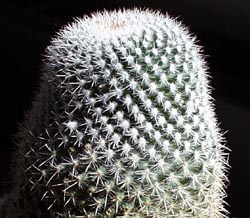





|
1. Observing Spiral Patterns > 2. Spiral Applet > 3. Dynamical Model Applet > 4. Cylindrical Spirals > 5. Cylindrical Spirals Applet > 6. The Farey Tree and the Golden Mean 4. Cylindrical Spirals 
In the three previous sections, you explored spiral structures that are observed when looking at a flower from above, or a pine cone from below. These patterns often continue into spirals wrapping around the stem of the flower, the body of a cactus or of a pine cone. The geometry is not that of a plane with a center anymore, but that of a cylinder. In this section, we explore the kind of spiral leaves make around stems, scales and prickers around cylindrical pine cones or cacti. To the right is a view of such patterns on Leanne's Robertson's cactus that some of you pricked your fingers on a little while ago ( by the way, it has parastechy numbers 16 , 26 = 2 (8, 13), a kind of double spiral configuration we may talk about later) We have two reasons to study this new type of spirals: the first one is raise the awareness that the cyndrical and planar spiral are generated by the same mechanism. The planar spirals evolve, as the plant grows, into cylindrical ones. The second reason, more mathematical, is that cylindrical spirals, although less stricking to the eyes, turn out to be easier mathematical objects to study. In this section, we go over steps similar to Section 1, but instead of planar spiral, we observe and create planar ones. Task 20: Using plants that you have available (eg. cylindrical pine cones, cacti, pineapples, palm trees, flowers stems from which you may want to cleanly cut the leaves), observe and count spirals winding up in opposite direction up the cylindrical surface. Task 21: Using the loose cylinder circles sheet, find a way to place one dot on each line in such a way that, as you close up the sheet into a cylinder, the dots form a regular spiral. Use the bottom black dot as your starting point. You may want to cut one white margin of the sheet to have the printed lines nicely close up into circles around the cylinder. Task 22: What kind of rule similar to that of the Remark in Task 2 are you applying to make your construction? What kind of geometric objects do you get when the sheet of paper is flat and you join the dots of your spiral in the order you have drawn them? Task 23: Now use the tight and tighter cylindrical circle sheets to experiment with different types of cylindrical spiral. The way your spiral changes should be determined by the position of the first dot you draw above the line with the printed dot. Play with the position of this point until you observe interesting patterns. An efficient way to do this is to experiment in groups, each person choosing different starting position, and comparing notes at the end. Task 24: Connect the dots using the same closest neighbour rule as you did (or should have!) in Task 5. Try to find families of them winding in opposite directions, and count them. Congratulations! You have now found cylindrical generative spirals and parastechies. As before, the apparent spirals, especially in dense structures, are usually the parastechies, which join points with their nearest, or second nearest neighbour. And as before, the number of parastechies are usually successors in the Fibonacci sequence. 1. Observing Spiral Patterns > 2. Spiral Applet > 3. Dynamical Model Applet> 4. Cylindrical Spirals > 5. Cylindrical Spirals Applet > 6. The Farey Tree and the Golden Mean |
||
